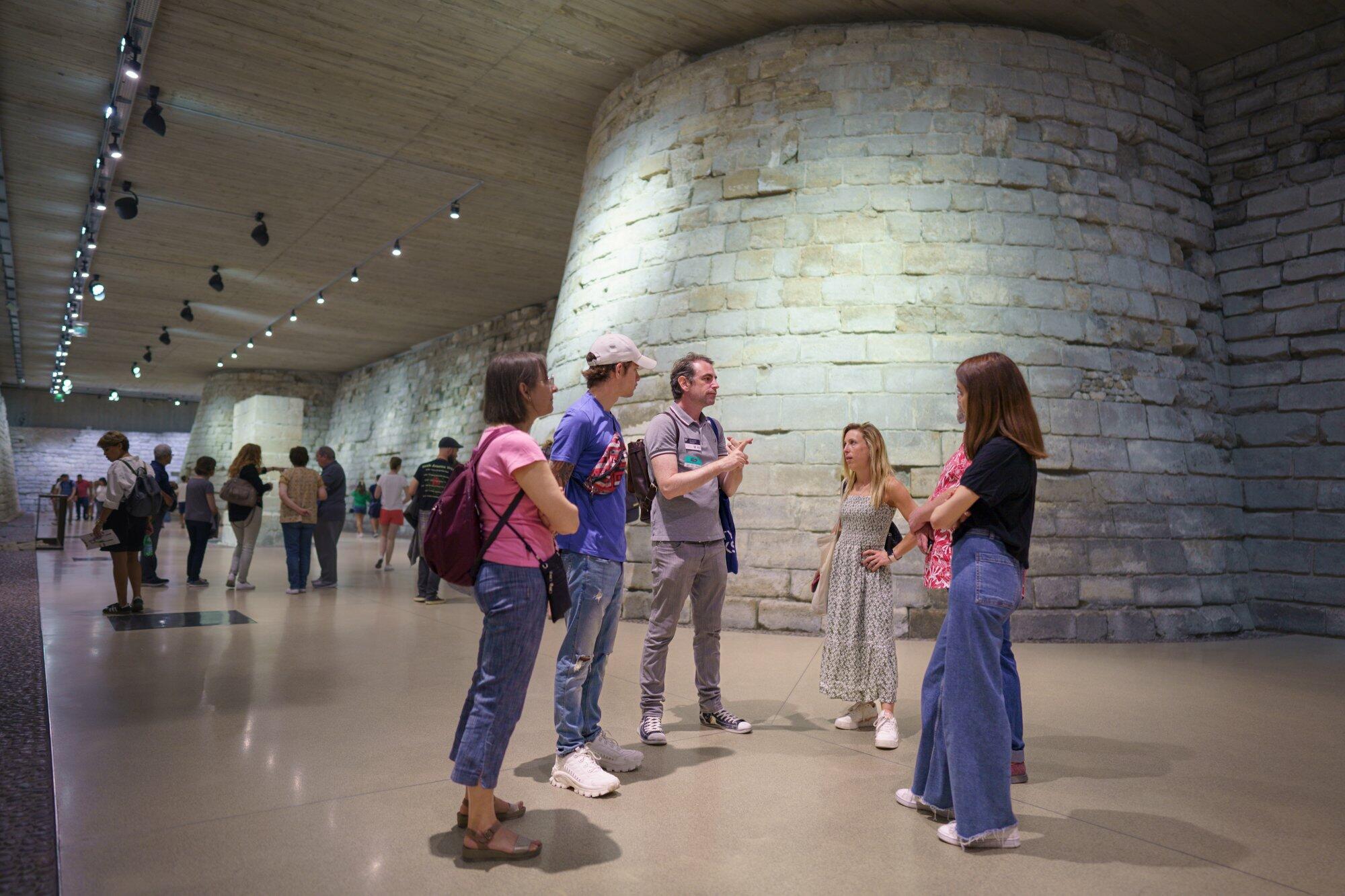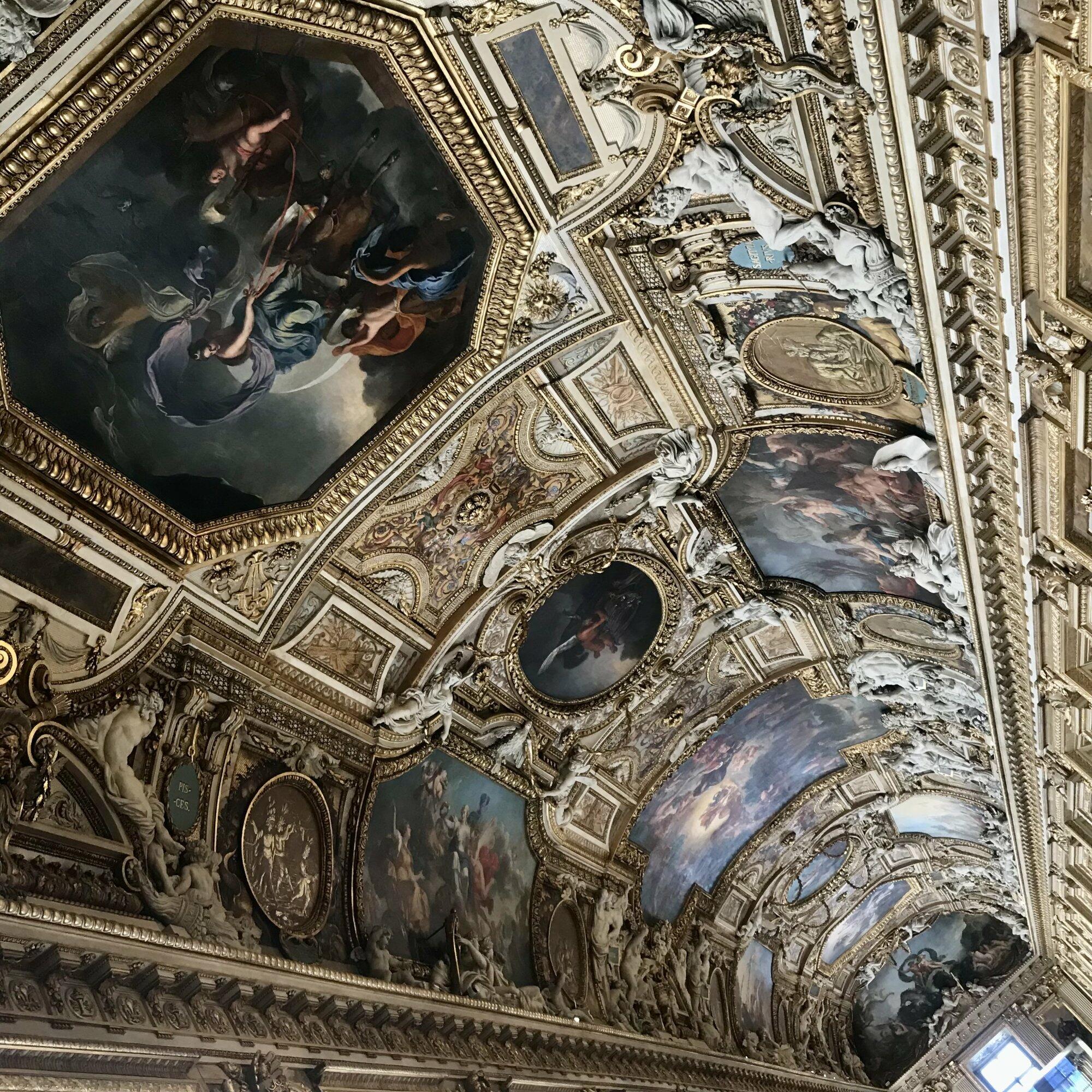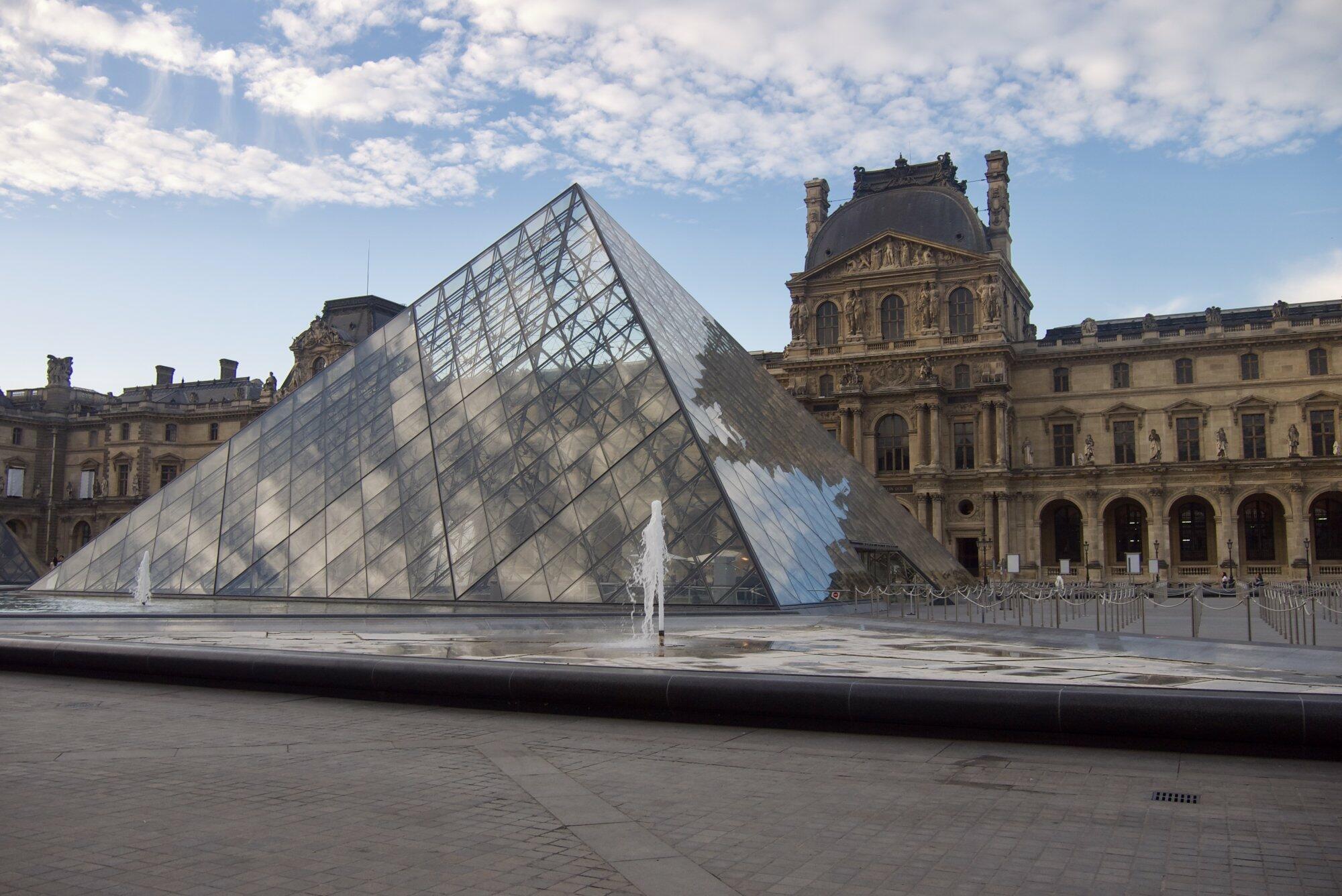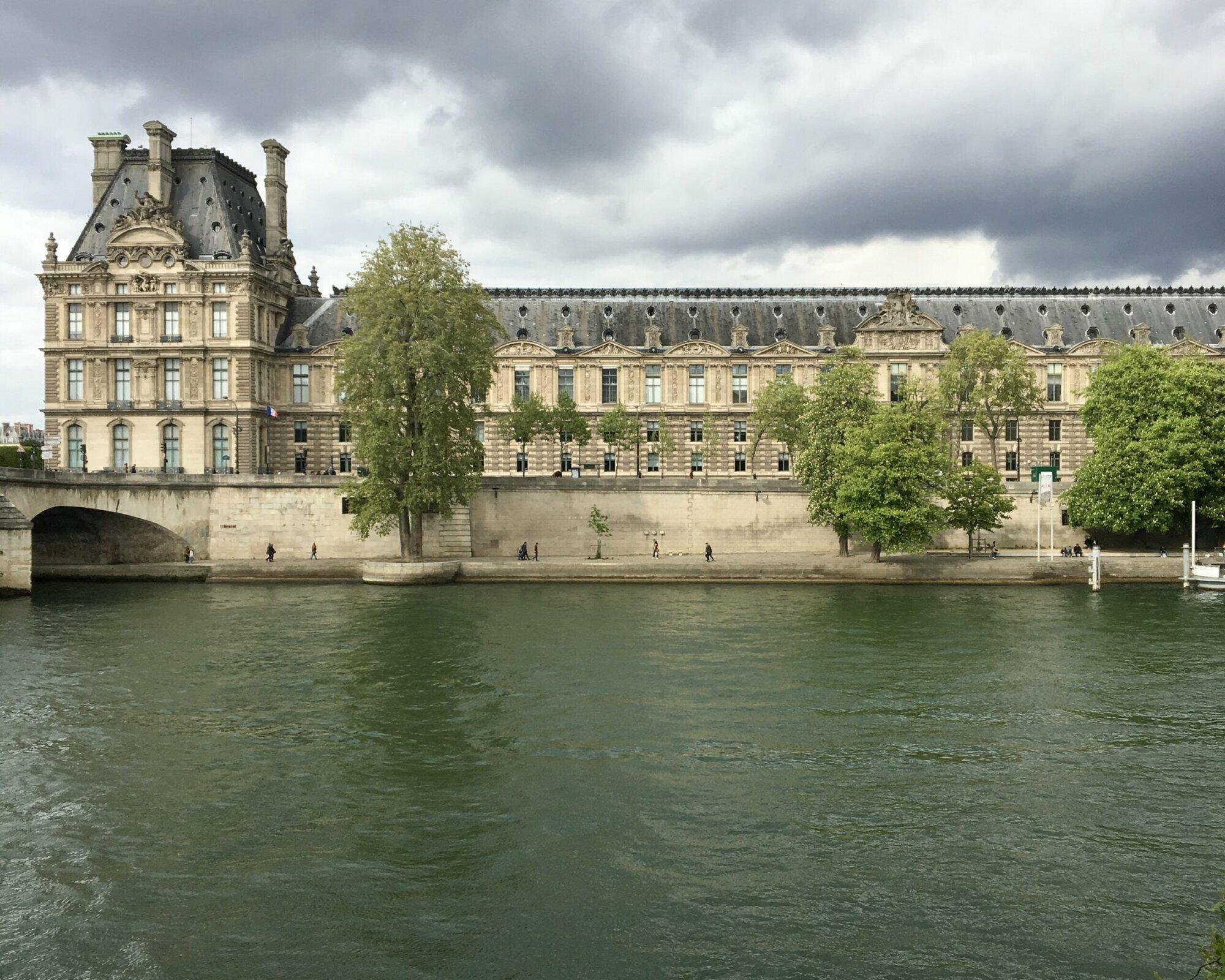Although the origins of the museum’s name are lost to the mists of time, the Louvre has, over the centuries and across languages and cultures, come to mean the museum par excellence.
A must-see stop on every visitor’s time table, the Louvre --perhaps the greatest museum in the world-- needs no introduction. With the largest collection of Leonardos in existence, its stunning Egyptian rooms, the Venus de Milo, the Winged Victory of Samothrace, and tens of thousands more pieces, the Louvre is a treasure trove stretched across eight miles, end to end, or some 15 acres. The museum is made of many, many rich and vast different collections, so much so that this article can only touch on some of the main points of it’s history and treasures.
A better understanding of both the building and its holdings can be enjoyed through booking a guided tour with us here at Memories France. An expert guide will take you through the highlights, at a precise booked time to avoid the lines (you will be sharing space at any given moment with some 15,000 other art lovers), show you the stars of this art scene and explain the history of the Louvre in Paris, one-time palace turned world-class museum.
History of the Louvre, Paris, France
Our tour can tell you so much more, but a smattering of Le Louvre facts must start with how the Louvre Museum came to be in the first place.

12th to 14th Century
- The King of France, Philip Augustus, had a plan. He was about to take off on a crusade, but he didn’t want to leave the good city of Paris unprotected. Thus he made the logical medieval move and surrounded it with a nice, thick wall and a tower keep. In the depths of the museum, you can still visit the formidable foundations of that keep and wall that was to guard Paris from all harm.
- In the fourteenth century, Charles V the Wise moved the royal household from the Palais de la Cité (where he had been attacked as crown prince in the Hundred Years War) to this impressive structure and renovated it into a residence fit for a king. More bookish than warriorlike, he ordered a lantern lit in his library at all hours of the day or night, as you never know when you might need to peruse the adventures of Lancelot or a treatise of cutting edge Arabic philosophy.
- Proud of his renovations, he even played tour guide to the Holy Roman Emperor, showing him the mighty glories of the domesticated fortress, inside and out (and you can’t beat a guided tour of the Louvre, we might add!)
16th Century
- Then along came Francis I, the king who did so much to build up the breathtaking beauty of the Loire Valley châteaux. An old stronghold would not do for the princely tastes of the man who had the Chateau de Chambord built, thus he had the old Louvre torn down stone by stone. What replaced it was a Renaissance-worthy palace replete with façade statuary, marble halls and corridors, cornices and caryatid columns for splendid ceremonials. (Tip! Don't miss the stunning Salle des Caryatides on a visit to the Louvre).
- If one thing had inspired the king, it was his time spent in Italy, fighting wars, but distracted by the dazzling talent there on display. Even though held for ransom, he managed to pick up Leonardo da Vinci as a souvenir of his Italian travels.
- In his bags, Leonardo kept an unfinished portrait of a Florentine merchant’s wife with her mysterious smile, quite a consolation prize for the losing king. She became, as we know, the Mona Lisa of today and is the hallmark of France’s painting collection.
- Kings and Queens after him continued on collecting artists and art. One example is Rubens’ entire hall’s worth of canvases showing Marie de Medicis arriving in France with all the overblown deliciousness that we know of that painter.

17th - 18th Centuries
- By the 17th century the royals took up residence elsewhere (an entirely different story that you can take up with our Versailles tour) leaving behind their vast collection of some 18,000 art pieces.
- By the 18th century the rest of the palace housed artists, some of the very painters whose work you’ll admire here – Jacques Louis David, Fragonard, and many others. Their children played on the rooftops, which the authorities tried in vain to forbid. They married amongst themselves, had affairs and squabbles, but when the Revolution hit, relayed each other in the bread lines.
Revolution and Napoleon
- In 1793, at the height of the Reign of Terror that followed the French Revolution, and with the guillotine at its constant work just over the way at today’s Place de la Concorde, the building officially opened to the people, known as Le Muséum.
- By 1803, from Napoleon Bonaparte’s coup to his 1815 downfall, it was known as the Musée Napoléon, with much of the collections his wartime plunder (Egyptian Campaign, anyone?) 5000 or so pieces were later returned to their home countries, but some of it is still here.
Nazi Occupation, 1940-1944
- In 1940, The Nazis came goosestepping down the Grande Galerie expecting to become masters of the museum’s treasures, but only empty frames awaited them. The masterpieces had all been stashed away in châteaux out in the country, some tucked away behind fireplaces, in a meticulous plan put together as early as 1938-39.
- The era’s curator tried to alert the RAF to these hideaways, to avoid bombing. London radio responded in code: ‘The Mona Lisa is smiling.”
- Not all of the works, particularly sculpture, could be evacuated and so the German Occupation re-opened the “Museum of Emptiness” as it was commonly called.
Today

- Inaugurated in 1993, The Glass Pyramid – a nod to the Egyptian collection – was built by Chinese-American architect I.M. Pei at the request of President François Mitterand in 1988, causing the same outrage as the Eiffel Tower did in its day. Its classic lines may contrast with the ornate exterior of the palace but their very differences accentuate the beauties of each style.
- Its construction facilitates the 9 million visitors that cross its threshold each year, who come from near and far to admire the works, now at 35,000 and growing!
Must-See at the Louvre: 20 Astounding pieces that we recommend you don't miss!
Once more, a blog entry can only do so much. So much better to have a friend from Memories France skip the lines and take you straight to the most interesting and famous art in the Louvre Museum, explaining each work to you in-depth and there to answer questions. Here however, are a few of our favorites to give you an brief idea:
1. Mona Lisa by Leonardo da Vinci c. 1505
photo: C2RMF (Wikipedia)
This superstar is a hard beauty to catch a good look of, since she’s at the top of everyone’s list of must-see things at the Louvre and the crowds around her all want her autograph. Luckily her eyes follow you. With even a glance her way, however, her smile will stay with you and you’re not even sure why. The secret though, is this: Leonardo was fascinated by the soul peeking through in the subtlest shows of emotion. So when the Florentine merchant Giocondo (or “merry”) commissioned a portrait of his young wife, the artist laser-focused on the point where the lips join in the hint of a smile, suggested by shadow. Moreover, he painted it with a reflective white undercoat precisely so that it would haunt you for ever after. Yet, he never finished the painting, instead packing it up with his worldly belongings when he moved to France as court painter to the King, touching it up over the years until his 1521 death.
Don’t miss the other Leonardos that visitors seem to just wander past, such as The Belle Ferronnière, the anti-Mona Lisa, whose lips seem to pout and whose eye avoids you no matter what angle you take.
2. The Great Sphinx of Tanis 2620 / -1866 BCE (Noubkaourê Amenemhat II; IVe dynastie [?])
photo: Jörg Bittner Unna (Wikipedia)
Riddle me this: What would it look like if we could splice animal strength with a human, even godlike, mind? The result might be something like this creature found in the sandy ruins of the Temple of Amun-Ra at Tanis in Egypt, as though guarding it. The colossal statue takes a lion’s muscled, crouching body and a man’s head -- not just any man, but Pharoah’s likeness, who was considered a god on earth -- and creates the hybrid sphinx. The sheer size of it (perhaps the largest sphinx outside of Egypt itself) ready to pounce, despite its colossal form, cries out the ruler’s power. Resist any temptation to feed it!
3. The Slaves by Michelangelo c. 1525
photo: Jörg Bittner Unna (Wikipedia)
It was said of this master that, with his wet nurse a stonemason’s wife, he drank marble dust in his breast milk. Michelangelo himself used to say that within a block of marble, he could see “signs of life” struggling to get out, and it was his job to free them. So masterful is the chisel that worked these figures considered Louvre must-sees, you barely register that they are unfinished pieces. In fact here, the appropriately named “Slaves” might be seen as liberating themselves from the prison of the very remaining stone.
4. Liberty Leading the People Eugène Delacroix 1830
photo: Shonagon (Wikipedia)
Upheaval after upheaval marked France’s whole nineteenth century. This is the Revolution of 1830 that Victor Hugo told the tale of in Les Misérables, a recently restored painting done a few short months after the barricades came down. Delacroix did not take part but afterwards cried out, “If I haven’t fought for my country, at least I will paint for her.” So stirring a call to arms was the result, that only some fifty years later was the painting’s place in the Louvre assured. Look over at his Death of Sardanapalus nearby, an orgy of color. Here it's almost hard to believe this is the same painter, for instead of a glamor of bright, striking hues, we nearly choke on the smoke and dust of battle. Yet there is a note of color, or three notes: the blue, white, and red of the French flag, for the liberty equality fraternity they stood for, raised in defiance, as it was illegal to display at the time the battle was fought. Can you hear the people sing?
5. Psyche Revived by Cupid’s Kiss Antonio Canova 1787–93
photo: Jean-Pol Grandmont (Wikipedia)
The God of Love, Cupid saves his beloved Psyche from jealous Venus’s attempt to murder her (Mothers-in-Law!) Canova’s sculpture is as romantic a piece as ever marble showed, with the lovers in a lyrical ballet of an embrace, entirely given over one to the other. Canova has perfectly rendered the tender tension in the space between the two pairs of lips, and yet the stone’s stark whiteness underscores an innocence, between the soul and desire in a world from before the notion of sin stained it.
6. Winged Victory of Samothrace Pythokritos of Rhodes (?) ca. 190 bce.
Photo : Lyokoï (Wikipedia)
The heroic figure struggles against a gust of wind to land and tell the great news, which explains her other name Nike, Greek for Victory. The brilliance of the sculptor of this Louvre Museum must-see has made you feel, through the thrust of her gigantic wings, the very invisible gales she is fighting in order to alight and greet the people with the tidings of victory. She will win against them, in spite of the unequal powers at play, despite all odds she will win, for this is her nature, she vanquishes the opposing winds as she lands. Why though does this figure of pagan Greece so resemble wingedbearers of glad tidings in the Bible? In Greek, the language of the Gospel, the word for messenger is angelos.
7. The Lacemaker Johannes Vermeer 1669-1671
Photo: Philippe Lelong (Wikipedia)
This is less a portrait of a woman, with her face left purposefully vague, as though seen through a slightly blurred glass. In fact the most precisely defined element is the most immaterial: the thread she holds. More than a likeness of her features, it is an image of her deep concentration at a task, even the result of which is hidden (we simply see the accouterments of cushion, pins and thread). What results is the portrait of her complete absorption, a deeply private moment. She remains entirely in a world of her own, that we cannot access, except through the genius of Vermeer’s portait of a woman’s inner life.
8. The Wedding at Cana Veronese 1562-1563
photo Shonagon (Wikipedia)
We may remember the Bible Story in which Jesus turns water to wine for a wedding, and not just any wine, but the best wine. To honor the occasion, the Venetian Veronese did it up big for the wall of a monastery’s dining room, and an exceptionally Venetian painting it is. He turned the event into a huge spectacle, with a typically Venetian theatrical backdrop, and as the musicians, rival painters Titian and Tintoretto (whom you’ll see on the surrounding walls in the same Louvre room). Note the detail of the transparency of the glass holding this wondrous wine, allowing us to witness its transformation. This kind of transparency of the material was a specialty unique to Murano glassmakers, as if to say, only an exclusively Venetian creation could be worthy of holding the first public miracle of Christ.
9. The Raft of the Medusa Théodore Géricault 1818–19
photo Unknown source (Wikipedia)
The Medusa was in some respects the Titanic of its day. Official incompetence abandoned a sunken ship’s passengers to certain death on a makeshift raft not big enough even to hold them. For the greatest, uncompromising realism, Géricault insisted on interviewing survivors, who even had to resort to cannibalism, and on using medical corpses to model the dead, those figures closest to us. It cannot surprise us that the artist finished the painting with a nervous breakdown. One of the most moving as well as scandalous of the painter’s choices, here in a world in which Napoleon had restored slavery, was to place at the peak of the painting’s pyramid a Black man as the hero, hailing, hope against hope, another vessel to come to their rescue, and, in the face of stupendous odds, succeeding and winning the day for all the survivors.
10. Venus de Milo II century BCE ? Alexandros
Photo Shonagon (Wikipedia)
The Louvre’s “other woman,” this Venus bears at its base the inscription “Alexandros, son of Menides, citizen of Antioch of Maeander made the statue.” She was discovered by French officials and a local farmer on a small Greek island, where the sea is never far, reminding the viewer of the goddess’s birth. Now armless, she once held the apple of discord --not to be confused with Eve’s-- that started the Trojan War. She rises out of her pedestal like a pillar, ageless, her own mystery, like Leonardo’s Mona Lisa, from another age. As she joined the ranks of the Louvre’s ladies just after her 1820 discovery, it is thought she may have served as model to Delacroix’s Liberty figure for his Liberty Leading the People painting higher on this list.
11. Hammurabi’s Code ca. 1760 bce
photo : Mbzt (Wikipedia)
This is the world’s first surviving trace of a written law code. Here the ruler Hammurabi, much like Moses, receives divinely ordained law inscribed on a stone tablet, directly from the sun god Shamash. Note the king is not on his knees, as was the hero of Genesis, but standing, eye to eye with the deity. The cuneiform script of the lettering seems to flow from him, and the very fact of it being inscribed in diorite gives meaning to the term “written in stone.”
12. Winged Bulls of Khorsabad (Lamassu) 721-705 BCE
photo M. Chohan (Wikipedia)
The Lamassu, a figure showpiece of the Assyrian Khorsobad palace, in today’s Mosul, Iraq, protected thresholds, liminal places understood to be vulnerable to outside attack, physical or metaphysical. And indeed with their human head and bull’s body topped with bird wings you definitely hope to get on their good side. Sculpted to stand at the palace entrances and or facing streets or courtyards, they are meant to be seen both head-on or in profile, as we can tell by their peculiar five feet – giving them a static appearance when facing them, whereas from a side view they seem to be walking, an early sucess at capturing motion in image.
13. Bathsheba at her Bath, Rembrandt 1654
photo: Unknown source (Wikipedia)
Rembrandt takes the tradition in the reclining nude, and completely upends what is usually eye candy, by giving his subject a tragic inner life. This beauty has a mind and that mind is deeply preoccupied, for the letter she has just read notifies her that King David has seen her bathing, and, having sent her husband to die in war, has now summoned her to the palace. Does she even have a choice? She prepares to meet her fate in a dramatic lighting Rembrandt drew from Caravaggio. Originally the painter thought to have her eyes lifted in prayer, but changed his mind. In having her look downward, we understand more that she's thinking, reflecting on all this and an immense sadness infuses her features.
14. The Sarcophagus of the Spouses late 6th century BCE
photo sailko (Wikipedia)
This Etruscan Masterpiece is a tomb sculpture: Wife and husband are after-living it up, equals in size and thus humanity, together forever. Death does not do them part. Like hosts, the smiling spouses, lift a cup to your health, as though the great beyond were a dinner party in eternity. This is a far cry from any other nearby culture’s approach to the hereafter, not Greek, not Roman, not Christian. Do you lift your glass and toast in turn ?
15. Mlle Rivière, Jean Auguste Dominique Ingres 1805
photo : Shonagon (Wikipedia)
This young girl, Caroline Rivière, who might have wandered out of a French translation of a Jane Austen novel, is pictured on the Louvre wall between her doting parents, Philibert and Sabine. Ingres, often seen as master of the line as opposed to rival Delacroix’s color, has given us the most delicate and even precious rendering of this thirteen-year-old beauty, in a white gown, that, though fashionable, accentuates her innocence, as does her fur stole that seems to at once both protect and cuddle her. The painter has, quite inhabitually, set her in a landscape that he never after used for women, as though his sitter is still enjoying the freedom childhood’s end, a state she will never leave, as she died the year after the portrait’s completion. Thus Ingres’ image has preserved her in a kind of amber, a girl eternally on the precipice of becoming to a woman, never to arrive.
16. Watteau’s Gilles 1718-1719
photo: Fanghong (Wikipedia)
With Watteau’s wistful delicacy of brush, the Rococo artist had captured this man whose melancholy attitude belies his costume of out of Italian comedy. You can see his fellow actors grouped at his feet. Although the costume identifies him as the unlucky-in-love Pierrot, we cannot help but see in him the archetype of the sad clowns whom have always been with us, some of them in our own age, whose laughter hides their tears. “But Doctor, I am Pagliacci’.
17. Titian’s Concert Champêtre ca. 1500 / 1525
photo C2RMF (Wikipedia)
The title could translate to “the countryside concert” in which two musicians seem to picnic in a verdant, misty setting. Titian, master of Venice’s painters, takes that city’s love of landscapes and greenery (there couldn’t have been a lot of trees and grass in the middle of the marble floating on the salt sea) to show – what? It’s never been entirely clear what exactly is going on here. Are the nudes muses, there to inspire the musicians? Do the men they even see them? Another thing the Venetians loved for their easel paintings (as opposed to Florence’s wall paintings which only had, ideally, one owner) were confusing subjects, that, changing hand from collector to collector, could morph in meaning for the eyes of whomever the currently possessed it.
18. Death of the Virgin Caravaggio 1606
photo Masur (Wikipedia)
It’s hard to believe that this incredibly moving image of Jesus’s mother’s passing could possibly have scandalized viewers at the time, but Caravaggio reveled in scandal and knew just how to trigger the church hierarchy. It might not come as a surprise that he used a courtesan to pose as Mary Magdalene, oft-reputed as such, but there were rumors too that the very Virgin herself was modeled after the painter’s own sex-worker mistress. Moreover, the bloated body of the Mother of God, herself a product of the Immaculate Conception, seems all too prey to “the thousand natural shocks/that flesh is heir to” as Hamlet might have said, when more typical representations of the scene were about transcendent glory. But in dwelling on the bodily details of mortality, the grief of those who loved her makes so much more sense, and we feel it along with them.
19. Oath of the Horatii, Jacques-Louis David 1784
photo: wartburg.edu (Wikipedia)
It often comes as a surprise to people to learn that this painting of patriotic sacrifice – it shows three young men swearing to their father to protect Rome to the death – was painted some five years before the Revolution broke out. It was even commissioned by the King himself, the very man whose death the painter will vote for nine years later. Revolutionary muckety-muck, David will even plan the new nation’s civic celebrations. You can detect here his sense of directing a theatrical tableau, something to inspire onlookers to action and love of the Republic, and this, all in a radically new muscular Neoclassical language that entirely rejects the soft feminininity of the Rococo that preceded it. This is entirely new stuff and so delighted were David’s pupils in his rousing success that when this débuted on the Salon walls, that they carried him home shoulder high and triumphant over the entire French school of the future. And what a future that would be!
20. Portrait of Madeleine by Marie-Guillemine Benoist 1800
photo :Shonagon (Wikipedia)
The painter Marie-Guillemine Benoist (1768 – October 8, 1826), a student of David, made her living by her brush, a story in and of itself, this is about her choice of sitter, whose name, Madeleine, has only recently been restituted to her. Only nine years before her appearance on the Salon walls in 1800, the slaves of today's Haiti had risen up to reclaim their freedom, thereby inspiring one of the French Revolution's most glorious moments, the abolition of slavery in 1794. Here, the white of the sitter's dress, complemented by the red of her belt and the blue of the chair she sits upon seem to hearken to the ideals the tricolor stands for: Liberty, Equality, Fraternity (In two short years from her exposition in the Salon slavery will be reestablished by Napoleon in the islands that were her home). It has been noted that the artist’s signature is in the same pigment as the sitter’s skin, highlighting a sense of sisterhood, and underlined by her placing it along Madeleine’s lovely hand, as though both of these women were the creators of this image.
These 20 works offer the merest glimpse of the endless supply of the Louvre Museum’s wonders for the eye, a tantalizing taste of its enchantments. Our tour of the palace and its collections can show you so much more. Moreover, with our advanced reserved booking times you skip the lines, and your guide knows the best routes around the 9 miles of corridors, in amongst the 15000 other people that you’ll be sharing the museum with at any given time! Bonus, once you’ve said au revoir to your guide, lines skipped and all, you are free to follow your own fancy to whatever collections speaks to you, with the knowledge and understanding that you’ve gained from your visit thus far.
Get the full Louvre Museum experience and book a guided tour for your next trip. Be in touch! We’d love to show you around!
Thank you!
Thank you so much for taking the time to read our blog! We are a small Paris-based tour guide company that prioritises a boutique personal experience where we can share our passion for our heritage and community with every individual that joins us. If you'd like to take a tour then head over to our website for an unforgettable trip to the city of lights. Also, check out our social media @memories.france for everything you could need to know for coming to Paris, from how to use the metro to coffee shops closest to each major monument, there is something for everyone!
Angelissa, Siobhan & the Memories France Family
If you're looking for more tips, itineraries, and insights into Paris, check out our social media!
Like what you see? Read our other blogs here!
- How to Use the Paris Metro: A Simple 6-Step Guide for First-Time VisitorsNervous about navigating the Paris Metro? Our practical, step-by-step guide covers everything you need to know — from buying tickets and reading the map to tips on avoiding common mistakes — so you can travel like a local with confidence.
- Can’t-Miss Summer Events in Paris 2025: Your Guide to What’s OnFrom music festivals and national celebrations to sun-soaked riverside fun, Paris truly comes alive in the summer. In this guide, we’ve rounded up the top events happening in Paris in 2025 — including Fête de la Musique, Bastille Day, the final stage of the Tour de France, and more — so you won’t miss a moment of the city's vibrant summer energy.
- 5 Best Châteaux to Visit Near Paris (within 90 minutes by train)Escape the city and explore royal estates, romantic retreats, and grand architecture—each less than 90 minutes from Paris by public transport. These five stunning châteaux are perfect for a memorable day trip into French history.
- Visiting the Iconic Notre-Dame Cathedral: What Not to Miss in ParisNotre-Dame Cathedral isn’t just a Paris landmark—she’s a symbol of the city’s history, heart, and resilience. In this post, discover her incredible story and get practical tips on how to visit, from what to look for to the best way to explore with a guide.
- Paris in a Day: The Perfect 1-Day Paris ItineraryRead here for our guide on how to spend one day in Paris. Showing you the major highlights, whilst still retaining that absorption of local culture, atmosphere and Parisian lifestyle that everyone comes here for!









